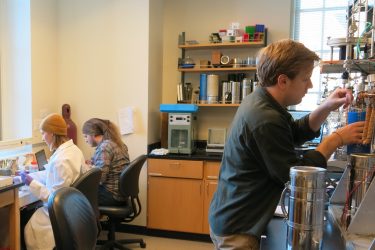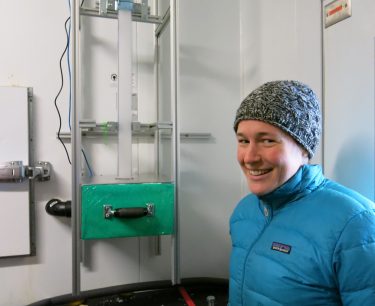Scientists know a lot about the Earth’s climate. Over the past sixty years, they have collected temperature and precipitation information, measured the amount of carbon dioxide in Earth’s atmosphere, and charted the changing weather. But what if we want to compare today’s climate to past climates—say, a million years ago or more? Traces of those past climates—referred to as paleoclimates—remain in rocks and ice as particles that once made up the ancient atmosphere, rain and soil.
University of Washington’s IsoLab brings together researchers from five different College of the Environment departments and programs. The state-of-the-art lab measures carbon, oxygen, hydrogen, nitrogen and sulfur, now trapped in rocks, soil and ice, like minuscule time capsules from prehistoric environments. “All of us in Isolab are to some degree interested in earth history over a variety of timescales,” says Becky Alexander, an IsoLab principal investigator from Atmospheric Science.
An Iso-what?

Isotopes are more than just Springfield’s greatest baseball team in The Simpsons. An isotope is a variety of a given element. For example, there are several versions of the element carbon: carbon-14, carbon-13 and carbon-12. Each isotope has the same number of protons but a different number of neutrons. The isotopes studied at IsoLab don’t break down very quickly. They can persist in rocks and ice for thousands to millions of years, so they are useful if we want to know about past conditions at Earth’s surface. For example, some water molecules are “heavier”, containing isotopes of hydrogen and oxygen with more neutrons. In hotter temperature climates, more water evaporates from oceans, so “heavier “water gets included in precipitation more often than during colder temperature climates. The isotopes of hydrogen and oxygen preserved in ice cores can tell us about temperatures of past climates. Similarly, isotopes of other elements give clues to past environments.
Enter Isolab
A collaboration between UW’s departments of Earth and Space Sciences, Atmospheric Sciences, Astrobiology, the Quaternary Research Center (QRC) and the Program for Climate Change, Isolab was founded in 2001 by Eric Steig and Roger Buick, both of the Department of Earth and Space Sciences.
But Isolab’s roots go much deeper. In 1969 UW researchers established the very first QRC to encourage the collaborative study of Earth’s past 2 million years. One of the first QRC hires, Minze Stuiver, established a lab to date geologic and archaeologic finds and to measure isotopes in seawater and ice for describing paleoclimates. When Stuiver retired, his lab closed, but IsoLab emerged from that legacy. “I didn’t decide to make a group lab but after the fact, we realized it was a good model,” says Steig, a former student of Stuiver’s.
“It’s expanded the scope of the research that I do because I have access to a variety of instruments,” says Alexander, who uses the lab to study the relationship between chemicals in the atmosphere and the changing climate, as well as modern atmospheric pollution. Her current work examines how sulfur found in living or once-living things, such as coral, affects sea-ice decline. She will be using equipment in IsoLab that she hasn’t used before, exemplifying the benefits enjoyed by researchers who access this shared resource.
A UW lab with a global impact

Isolab is a resource valued by the broader scientific community, with its facilities used by researchers throughout UW and the world. “A bunch of people on campus have used this lab in big ways,” says Steig. For example, scientists from NOAA’s Fishery Science Center, which is based on the UW campus, used the lab when their own equipment broke down. “They sent samples here and we were able to collaborate with them,” said IsoLab manager Andy Schauer. The group used Isolab to identify the geographic origins of certain salmon that were a popular food source among Orcas—information that could be used to protect or manage these important areas.
Researchers from the University of Vermont also used IsoLab recently to analyze water from ice core samples that were collected in Greenland during the 1960s. “The water is probably old water that was in the soil before the ice was there.” says Steig. The water was “heavy”, suggesting it originally fell, likely as rain, during a warmer climate. This means that at some point in the last million years, the sediment, now covered by ice, was exposed to rain. “The biggest questions for Greenland right now are, ‘were the ice sheets smaller and if so, when?’ It’s incredible that we have samples that we can work on,” says Steig. Obtaining new samples from Greenland would require drilling into the ice sheet, with great cost and difficulty.
There are only a few labs worldwide offering the technology found in IsoLab. Since it was established in 2001 the lab has provided UW faculty, students and regional scientists across a range of disciplines with significant opportunities to advance their research. “Isolab has really facilitated lines of research across the college and across the university that wouldn’t have been possible without this shared infrastructure,” says Alexander. Schauer agrees. “It’s an open facility and these tools are expensive. If there is another researcher [who] can’t afford a lab like this, they can come up here and get trained to use the equipment,” he says.

